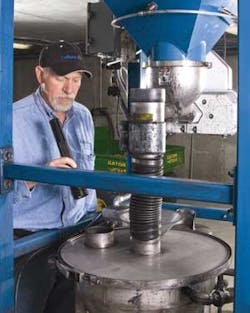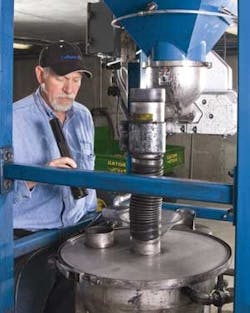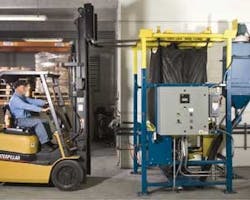Automated Handling of Activated Carbon Reduces Dust, Labor
Two cities, one in the United States and the other in Canada, over 700 miles apart, were experiencing nearly identical problems caused by manual addition of powdered activated carbon to their municipal water treatment systems. Both cities not only eliminated a health hazard caused by carbon powder dust, but also reduced the amount of labor required to add powdered activated carbon to the system by installing a bulk bag unloading system.
A plant operator inspects powdered carbon entering the washdown hopper.
The city of Swift Current draws its municipal water supply from a reservoir formed by a dam on the Swift Current Creek at an average rate of 1.5 mgd with a peak rate of 5.5 mgd. Potassium permanganate is added at a concentration of 1.5 parts per million (ppm), then powdered activated carbon is added in the form of a slurry consisting of 0.13% to 0.47% solids, and the water is gravity fed into a low well at a rate of approximately 25 gpm. Reaching a final concentration of 20 ppm, the carbon's function is to adsorb organic materials, eliminating unwanted tastes and odors.
After addition of liquid alum, sludge conditioners, and polymers in the clarifier, filtered water is pumped to a clear well located at the water treatment facility with a capacity of 180,000 gallons and to two reservoirs within the city itself, each holding 1.5 million gallons, for distribution to residents of the city of Swift Current.
City of Lafayette operator forklift-loads a bag-lifting frame onto the bulk bag discharger.
The city of Lafayette draws its water from two local reservoirs formed by dams on the Boulder Creek and from one reservoir on the South Boulder Creek. Consumption is approximately 2 mgd during the winter, but can reach as much as 10 mgd during the summer months. From the reservoirs, water flows into an onsite aeration and flocculation facility similar to that used by the city of Swift Current, where powdered activated carbon and other treatment chemicals are added. After final filtration, the water is pumped into three storage tanks, which together can hold up to 13 million gallons of water, for distribution to residents of the city of Lafayette.
PAC Feed
Prior to the installation of bulk bag unloading systems, operators at both facilities were emptying 35-45 lb bags of powdered activated carbon, generating carbon dust and putting physical strain on workers. Powdered activated carbon is an extremely fine powder with an average particle size of only 20 microns and a bulk density of 21.5 lb/cu ft.
At both facilities, installation of an automated bulk bag unloading and feeding systems from Flexicon Corp. eliminated dust while increasing operator safety and reducing manual labor.
The city of Swift Current now purchases 1100 lb bags and unloads 1 to 3.5 bags per week. The city of Lafayette unloads between one 900 lb bulk bag per week during the winter and as many as 4.5 bags per week during the peak summer months.
The Flexicon bulk bag dischargers incorporate devices that contain dust and promote complete discharge. A manual Spout-Lock® clamp ring is raised pneumatically by a Tele-Tube® telescoping tube, allowing an operator to make a high-integrity, dust-tight connection with the bag spout. The telescoping tube is then released to exert continuous downward tension on the clamp ring and, in turn the bag spout, which elongates the bag as it empties to promote complete discharge.
At the City of Swift Current, a bag is loaded onto the half-frame bulk bag discharger from a ceiling-mounted monorail. The frame below the discharger incorporates a 2000 lb capacity hopper, volumetric feeder, washdown hopper, and a liquid slurry eductor that draws carbon powder into a water stream.
Flow is additionally promoted by Flow Flexer™ pneumatically actuated plates that raise and lower opposite bottom edges of the bag, causing the activated carbon to flow into and through the bag spout.
A Power Cincher® flow control valve encircles the upper portion of the bag spout, allowing gradual discharge once the drawstring is untied, as well as retying of partially empty bags.
Mounted on the side of both unloading frames is a Bag-Vac® dust collector that draws displaced air and dust from a hopper vent during discharge, and collapses empty bags, dust-free, ready for tie-off and removal.
System Differences
At the city of Swift Current, a hoist from a ceiling-mounted monorail loads an 1100 lb bag onto a 5-foot-tall half-frame bulk bag discharger mounted on a 6.5 ft. platform. The discharger frame is integrated with a 10 ft. frame that holds a 2000 lb capacity hopper (for the contents of two bags), a twin-screw volumetric feeder, washdown hopper, and liquid slurry eductor. The powdered activated carbon flows from the bulk bag to the hopper and then to the feeder which meters it into the washdown hopper and eductor to blend with the 25 gpm water streaming toward the low well. A control panel regulates the dust collector, the bag activators, feeder, and flow-promoting air pads on the side of the hopper.
At the city of Lafayette an operator forklift-loads a 900 lb bag in a lifting frame onto a full-height 9.75 ft. discharger. The powdered carbon flows through the telescoping tube and 2 ft. downspout which extends through the floor to a 5-cubic-foot receiving hopper contained in a 7-foot-high frame which also holds the twin screw volumetric feeder, washdown hopper, and liquid slurry eductor. Controls govern the dust collector, feeder, and air fluidizers for hopper flow, and notify the operator to change empty bags.
Continuous blending of powdered activated carbon from the volumetric feeder with fresh water creates a slurry, consisting of as little as 0.006% solids in the winter to as much as 0.05% solids in the summer. It is added to the clarifier at a rate of 120 gal per minute, resulting in a final carbon concentration of 5 to 7 ppm.
"We basically just set it and forget it," Zimbleman said.
Design, Installation
The City of Swift Current system was designed by a local consultant in Regina, SK, with the help of Mequipco Ltd. that supplied the equipment, and was installed by a local Saskatchewan contractor. Mequipco (www.mequipco.com) is a manufacturer's representative, equipment supplier and systems integrator based in Calgary, Alberta, whose primary focus is on mechanical equipment for water and wastewater treatment. Dan Landry and Kevin Dickinson headed the Mequipco team that assisted with the system startup and design.
The City of Lafayette system was designed and installed by Flexicon Corp. (www.flexicon.com ) and Process Control Equipment Co. (www.pcecompany.com), a manufacturer's representative firm headquartered in Lehi, Utah, specializing in material handling equipment for powder and granule processing. Susan Aberle of the company's Wheat Ridge, CO, regional office assisted with installation and startup.
"We evaluated two other machines in addition to the Flexicon system," Zimbleman said. "Although they were similar, the other two manufacturers were unwilling to make the necessary physical modifications to our facility, including cutting a hole in a concrete floor in order to put the hopper on top of the feeder."
Several modifications were made after the system was installed.
"We were having problems with the washdown hopper clogging from time to time," Zimbleman said. "The hopper is 2 feet high and 2 feet in diameter at the top, but only 6 inches in diameter at the bottom. Susan and her team added jets with plastic nipples so the water circulated around the hopper instead of just spraying into it, which eliminated the problem." WW


